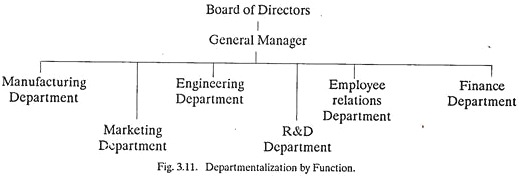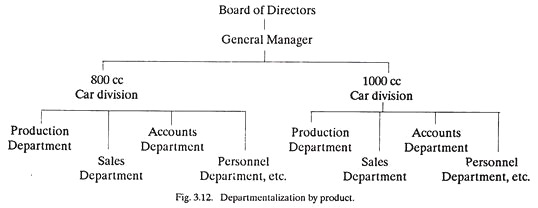After reading this article you will learn about:- 1. Meaning of Departmentation 2. Aims of Departmentation 3. Methods 4. Advantages.
Meaning of Departmentation:
When the size of an enterprise grows, the number of employees (persons) also increases. There is a limitation on the number of persons an enterprise can manage directly. This limitation restricts the size of enterprise if the enterprise does not opt for the device of Departmentation (i.e., horizontal differentiation). Departmentalisation is the process of breaking down an enterprise into various departments.
Hence, departmentation or grouping of activities into departments is very essential because it limits the number of subordinates (man power) to be supervised by a manager; it would have otherwise been very difficult to manage a team of large number of subordinates by a single superior and thus the size of the business enterprise would be very limited.
Identifying and grouping of similar activities on some logical basis so that a team of persons can be organized in order to attain the objectives of the enterprise may be called departmentation. A department is a work group combined together for performing certain functions of similar nature. The process of division of the enterprise into different parts is broadly called departmentation or departmentalisation and it is done for the purpose of administration.
Aims of Departmentation:
ADVERTISEMENTS:
(i) To group activities and personnel to make manageable units.
(ii) To bring specialisation in the performance of various activities.
(iii) To fix responsibility of the heads of various departments for the achievement of organization goals.
Methods of Departmentation:
Departmentation is the process which is used to group the activities of the enterprise into various divisions for the purpose of efficient management.
ADVERTISEMENTS:
Different methods of creating departments in an enterprise are discussed below:
(a) By Function:
Departmentalization by function is shown in Fig. 3.11, wherein the activities of the organization are divided into the primary functions to be performed-manufacturing, marketing engineering, research and development, employee relations and finance.
This arrangement has the advantage of the specialization and concentration of similar activities within a departmental unit. It is the most prevalent form of departmentalization and is seen not only in business enterprises but in hospitals, government agencies and many other kinds of organizations. The major problem associated with this form is the coordination of the specialized activities.
ADVERTISEMENTS:
(b) By Product:
Product departmentalization has become increasingly important, especially for large, complex organizations. Under this category, large organizations, have major product divisions with substantial autonomy. In departmentalization by product, product lines are segregated and each product line has its own manager, its own manufacturing, selling etc.
An automobile industry, for example, may departmentalise its activities as follows:
Advantages of Departmentalization by Product:
(i) Each product division could be considered as a viable profit centre for accountability purposes. It is easier to evaluate the performance of each product line. Unprofitable product lines may be dropped. Moreover, proper attention can be given to each product.
(ii) The problem of coordination as present in departmentalization by function is removed here.
(iii) Classification by product permits to make a maximum use of specialization in technical skill, managerial knowledge and capital equipment.
ADVERTISEMENTS:
Defects of Departmentalization by Product:
It increases management cost; duplicate service functions are required both at the top and operating levels of management. High cost of operation prevents the small and medium-sized concerns from adopting this basis of classification, particularly for creating major units.
(c) Departmentalisation by Customers or Markets:
Sales is the exclusive field of its application. To give individual attention to the diverse groups of buyers in the market, sales activities are often split into several parts. When the products are offered to an extensive market through numerous channels and outlets, it has the special merit of supplying goods according to the peculiar needs of customers.
ADVERTISEMENTS:
(d) Departmentalisation by Territory:
Market area is broken up into sales territories and a responsible executive is put in charge of each territory. The salesmen of each territory report to their regional or territorial manager who in turn is in communication with the sales manager.
(e) Departmentalisation by Process:
The manufacturing activities may be sub-divided on the basis of their process of production. Similar machines such all lathes, all drilling machines, all shapers etc., are grouped into separate sections, each kept at one place and used for a distinct operation on the job. This arrangement works alright for job order work and is unsuitable for mass production.
ADVERTISEMENTS:
In actual practice, no single method of grouping activities is applied throughout the organisation structure with all its levels. In reality, a single organization may employ one or all of the bases of departmentalisation at the same or various hierarchical levels.
Advantages of Departmentation:
(i) Since every-one knows precisely his duties and authority, the efficiency of the enterprise increases.
(ii) As jobs are well-defined and responsibilities well clarified, it is easy to fix accountability for the results.
(iii) The departmental managers are given opportunity to take initiative and learn new managerial skills.
(iv) Departmentation provides a basis on which top management can coordinate the activities of different departments.

